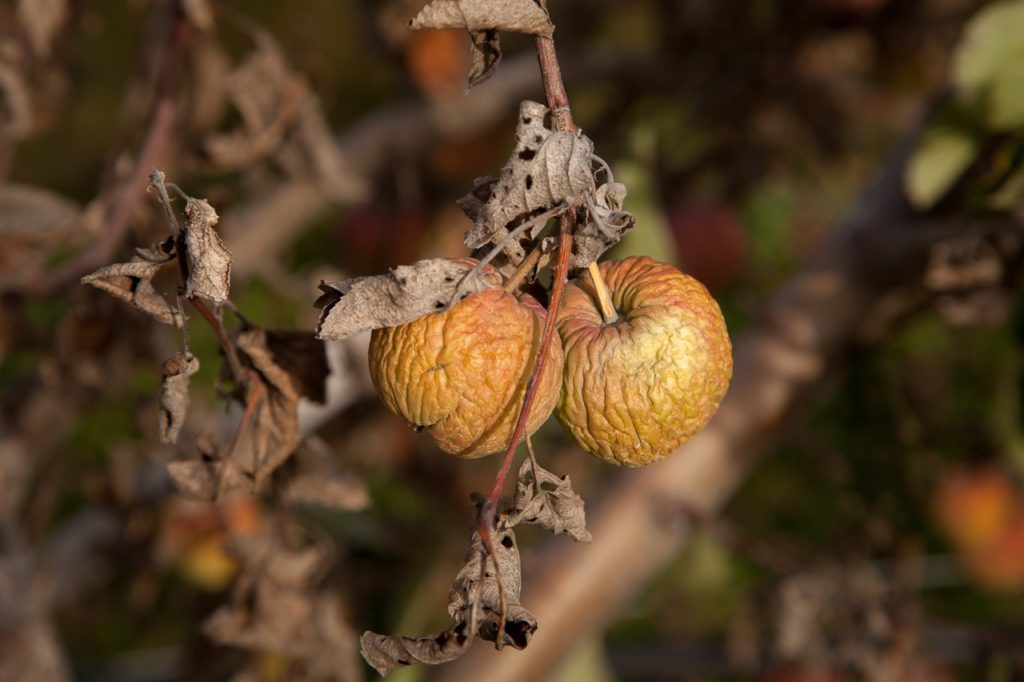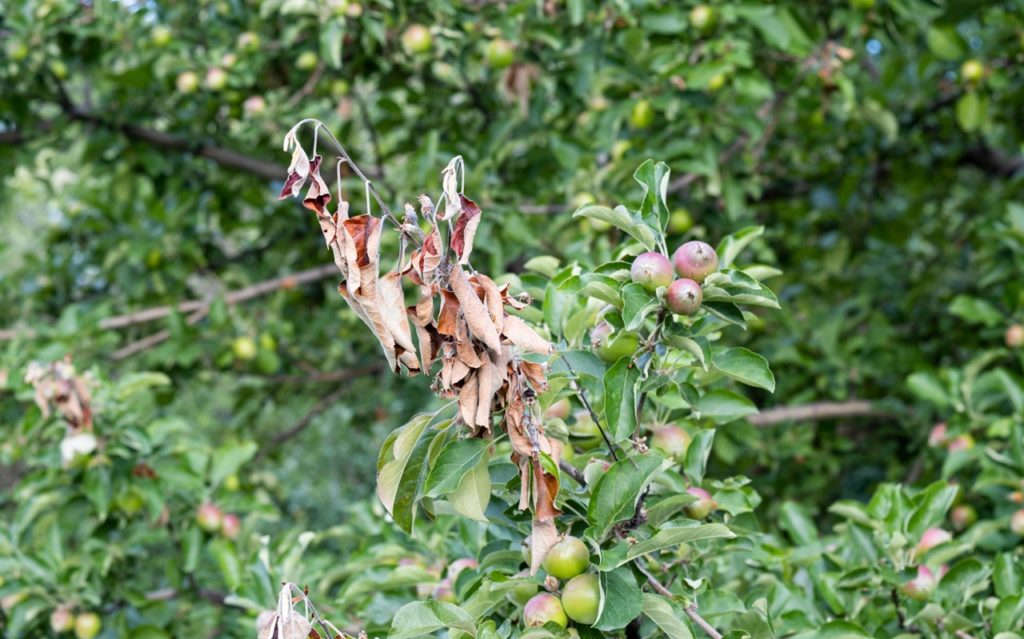Brown Leaves On Your Apple Tree? These Solutions Can Help With Recovery

Reviewed By COLIN SKELLY

Colin is a Horticulturist and Horticultural Consultant with experience in a range of practical and managerial roles across heritage, commercial and public horticulture. He holds the Royal Horticultural Society’s Master of Horticulture award and has a particular interest in horticultural ecology and naturalistic planting for habitat and climate resilience.
IN THIS GUIDE
If you have a prized apple tree in your front yard that is a joy to behold in spring when it colours up with fragrant apple blossoms, brown leaves might become an annoyance.
The bounty of luscious, juicy apples that you harvest season after season might be up against leaves that are browning quite alarmingly, and you might be wondering what to do.
Well, firstly, you need to try to figure out the problem or diagnose the disease, as apple tree foliage can brown from a multiplicity of causes, including:
- Waterlogging that causes your apple tree’s roots to rot.
- Underwatering your apple tree.
- Apple scab.
- Fireblight on your apple tree.
- Chemical burns caused by the overapplication of chemical spray on your apple tree .
- Potassium deficiencies in your apple tree.
I outline the factors that will allow you to identify the cause and treat it below.
1) Waterlogging & Root Rot
Though an established tree in open ground is rarely affected by overwatering and waterlogging, a sapling or a young tree may succumb to root rot, especially if it is planted in heavy, dense soil coupled with prolonged rains or excessive watering.
The only way to save the affected tree is by digging it up, cutting off the rotten portions of the roots and transplanting it into more amenable free-draining soil.

The common signs that waterlogging is the issue includes:
- The leaves curling up.
- The browning starting at the tips and the edges of the leaves.
2) Underwatering
If your apple tree has the following symptoms, then it might not be receiving enough water:
- The leaves are covered in random greeny-brown spots.
- These patches are randomly positioned over the leaves.
- They occur on both sides of the leaf’s surface.
- The branches from the tree are cracked and blistered.

This problem is the easiest one to rectify on this list, though you should make sure that the diagnosis is correct by checking your watering schedule.
You could also examine the soil down to several centimetres for moisture.
Give the tree a thorough soaking and then re-commence regular watering.
Water in the morning with cool water for the best results.
3) Apple Scab
Apple scab is a fungal disease that only some cultivars are susceptible to, but these include 3 of the most popular – ‘McIntosh’, ‘Red Delicious’ and ‘Cortland’.1Bill Shane, Michigan State University Extension. (2014, February 20). A review of apple scab-resistant varieties for commercial growers. MSU Extension. Retrieved March 9, 2023, from https://www.canr.msu.edu/news/a_review_of_apple_scab_resistant_varieties_for_commercial_growers
Best practice indicates avoidance measures such as the prompt clearance of shredded leaves and the pruning of diseased branches.
Alhough fungicides to control this disease are available, they are prohibited for use on fruiting trees.

You may treat a diseased apple tree with a fungicide, as long as you first ensure that it will not injure the tree and that you discard and destroy that season’s entire crop of apples.
You can identify apple scab from these symptoms:
- The leaves on a given shoot or branch are almost all browned.
- The leaves look like they’ve been scorched.
- The flowers on the tree have wilted and withered.
- Younger shoots have developed a hook or crook.
- There is some oozing or canker on the bark of the tree.
4) Fireblight
This bacterial disease is a serious one as, unfortunately, it has no cure.
To diagnose fireblight, check for the following:
- The brown leaves are scattered throughout the tree.
- The browning does not follow any pattern.
- You have used chemicals on your tree recently.
- The weather has been particularly sunny and hot and your tree has been exposed to it.

If the problem is caught early enough, your best shot is to trim and prune all of the diseased parts of the tree, including the branches.
This is a somewhat complicated operation which you will need to research thoroughly before attempting or bring in a tree doctor to do the job for you.
Sadly, in extreme or advanced cases, the diseased tree must be entirely destroyed.
5) Chemical Burns
“The foliage of your apple tree might have been burnt by chemical sprays, such as pesticides,” shares Colin Skelly, a Horticulturist whose previous experience includes 3 years working as a Gardener at St.Michaels Mount.
Other symptoms apart from brown leaves include:
- Yellowing and/or browning of the leaves.
- Distorted growth.
- Small, mishapen or curled leaves.

Luckily, if the affliction is not excessive, the tree will heal.
“Avoid further spraying of any chemicals and maintain moisture levels,” shares Colin.
“If the spray was a contact chemical then pruning out the affected area may limit the damage.
“If it was systemic (e.g., glyphosate), this will be less effective.
“The tree may recover over time but roots will be impacted, as well as foliage and stems.”2Weedkiller damage / RHS Gardening. (n.d.). Royal Horticultural Society. Retrieved April 11, 2023, from https://www.rhs.org.uk/prevention-protection/weedkiller-damage
6) Potassium Deficiencies
Apple trees require a soil pH in the moderately acidic range for the efficient uptake of nutrients from the soil.
If they are not receiving enough potassium, the leaves of the tree might begin to turn brown.
The main symptom includes brown edges on the leaves that may spread towards the centre of the leaf.3Potassium deficiency | Apples. (2018, April 30). Yara United Kingdom. Retrieved April 11, 2023, from https://www.yara.co.uk/crop-nutrition/apples/nutrient-deficiencies-apples/potassium-deficiency-apples/?activeSlide=4213
Alkaline soil can arrest the uptake of potassium from the soil.
References
- 1Bill Shane, Michigan State University Extension. (2014, February 20). A review of apple scab-resistant varieties for commercial growers. MSU Extension. Retrieved March 9, 2023, from https://www.canr.msu.edu/news/a_review_of_apple_scab_resistant_varieties_for_commercial_growers
- 2Weedkiller damage / RHS Gardening. (n.d.). Royal Horticultural Society. Retrieved April 11, 2023, from https://www.rhs.org.uk/prevention-protection/weedkiller-damage
- 3Potassium deficiency | Apples. (2018, April 30). Yara United Kingdom. Retrieved April 11, 2023, from https://www.yara.co.uk/crop-nutrition/apples/nutrient-deficiencies-apples/potassium-deficiency-apples/?activeSlide=4213

